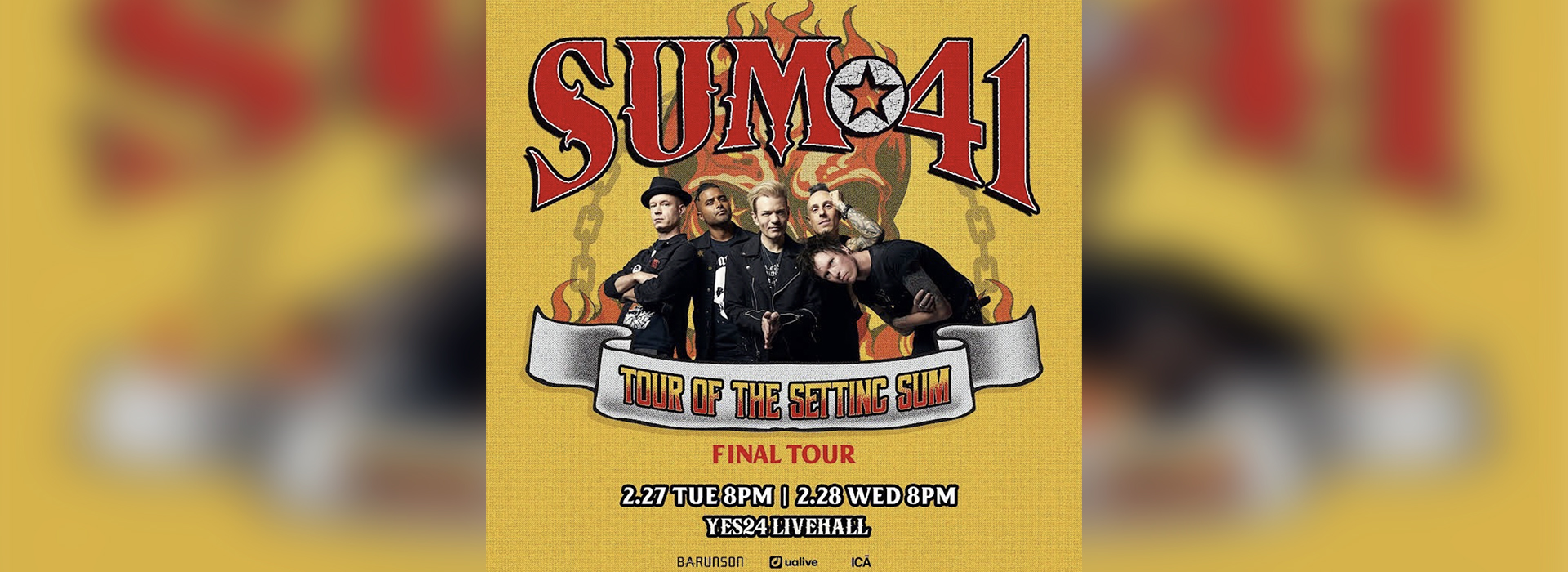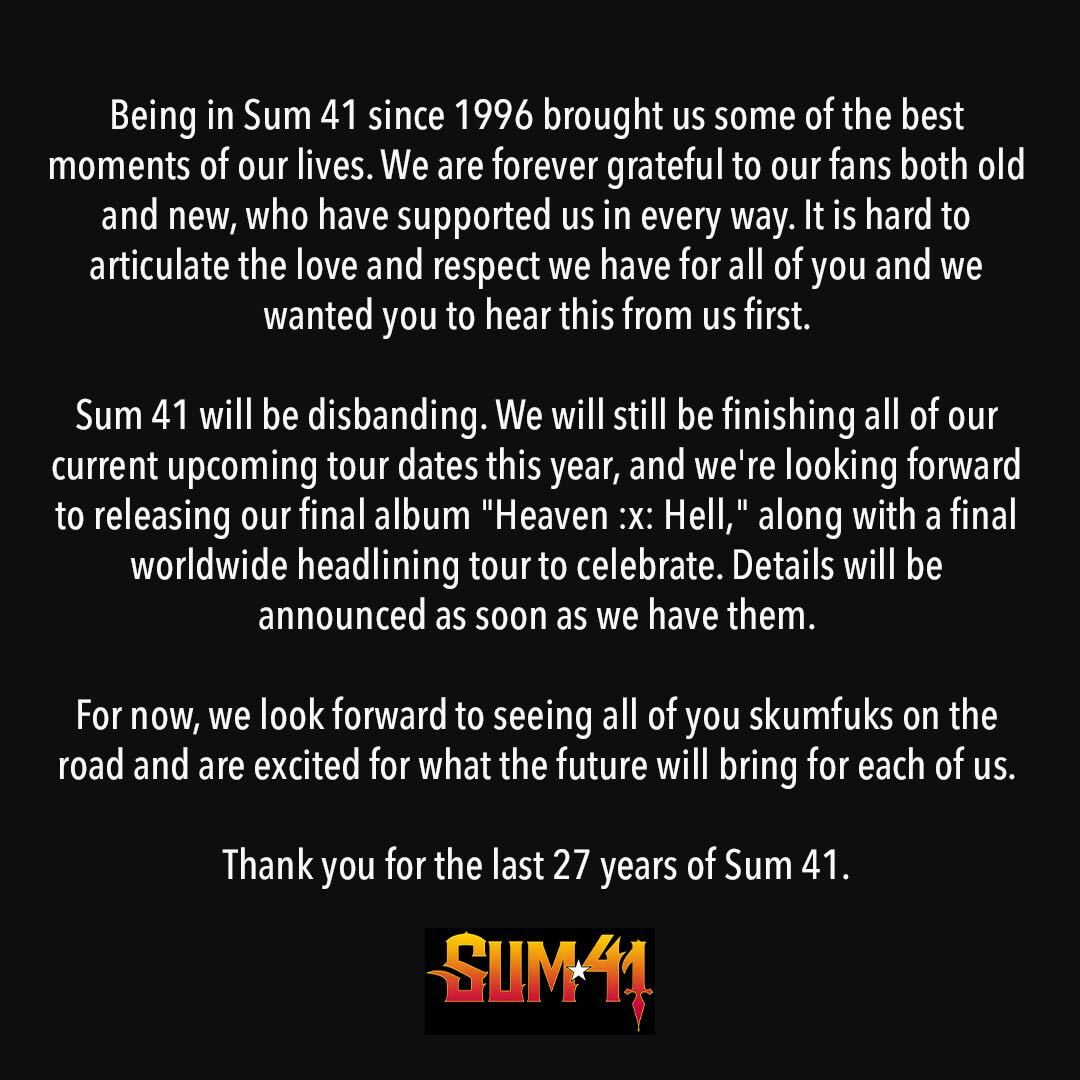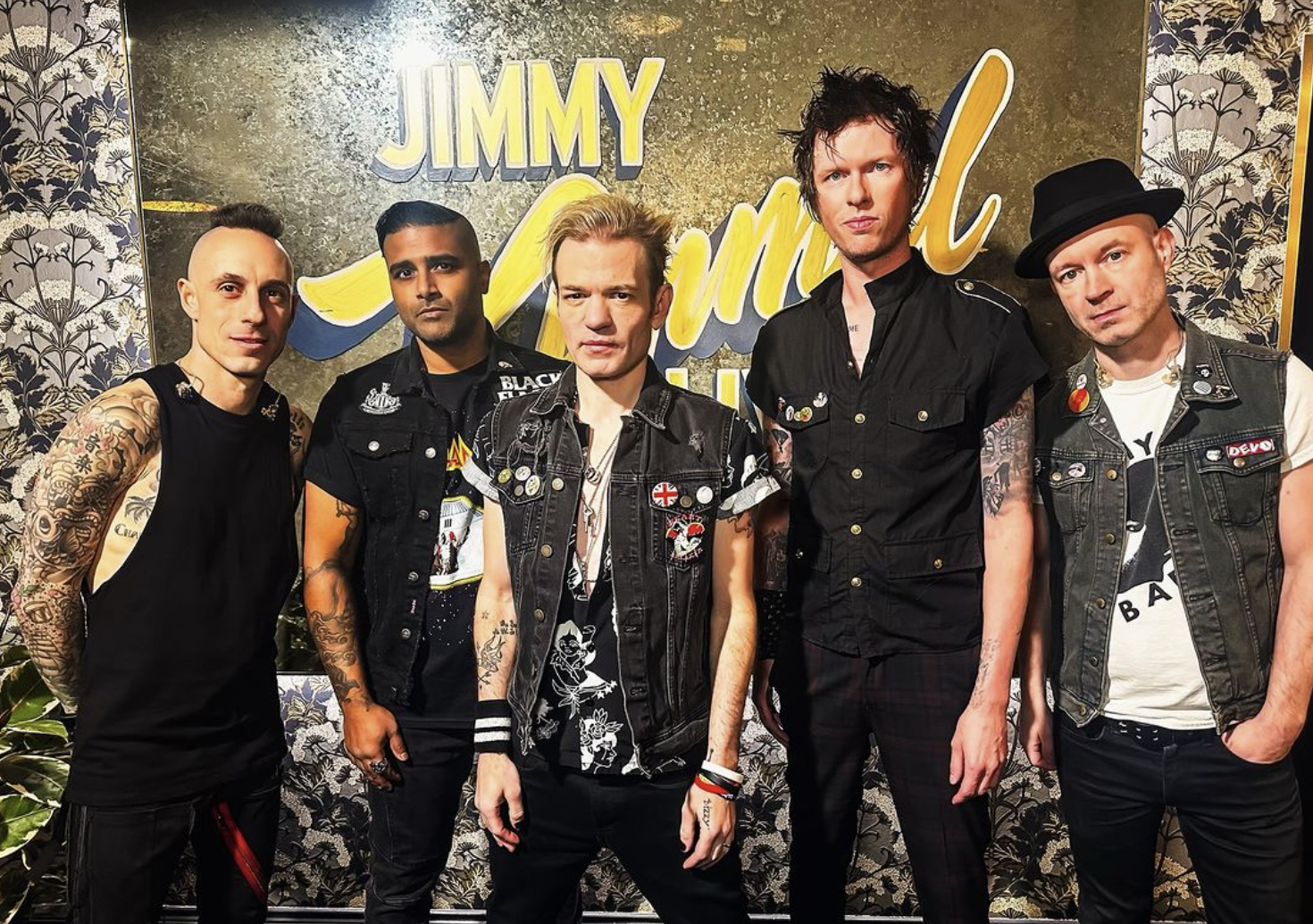
-
 ©️ SUM 41 X(Formerly Twitter)
©️ SUM 41 X(Formerly Twitter)
While Sum 41 was scheduled to play in Korea last March 28, the concert was shelved after one of the band members had to tend to an emergency. Shortly after, the band took to social media to announce Heaven :x: Hell—what is to be their final album—as well as their plans to part ways. Fortunately, they also promised a headlining world tour, which meant that Korean fans would finally see Sum 41 in concert—this time, for their grand farewell—on February 27 and 28 at YES24 LIVE HALL. The wild rebels who broke onto the scene at the turn of the millennium with seemingly limitless energy were now to settle forever into the lionized pages of rock music history.
An early incarnation of Sum 41 surfaced in Ajax, in the province of Ontario, Canada, as a band named Kaspir, led by singer Deryck Whibley. Kaspir was looking at bands like Nirvana and Weezer and taking notes. We remember Nirvana for their contributions to alt rock and grunge, but it was actually their punk rock that turned the world on its head. Kurt Cobain, who in his younger years was a fan of the Pacific Northwest punk scene, once described Nirvana as a punk band that played pop music. After Nirvana released their first album, Bleach, around 1989, and went looking for a new drummer, they ended up bringing Dave Grohl on board, the man behind the airtight beats of the band Scream, which played in Washington, DC, a Mecca for hardcore punk. When Cobain was asked in a 1994 Rolling Stone interview about grunge music, a term the media had created, he lamented how his band was “stuck in such a rut” because “grunge is as potent a term as New Wave. You can’t get out of it,” he said. “You have to take a chance and hope that either a totally different audience accepts you or the same audience grows with you,” he noted, personally bringing to an end a gloomy era. And, after Cobain died, new punk bands began to spring up, just as he had hoped. Weezer frontman Rivers Cuomo took what was then his metal band and shifted it toward power pop and punk rock, taking the 1980s hardcore punk ethos into the mainstream to embody the free and easy defiance of the slacker culture that resulted from the existential crises of the ’90s.
With bands like Weezer, Green Day, the Offspring, and Rancid arming themselves with more approachable melodies, the era of neopunk began. Kaspir found inspiration in the ’80s skate punk and melodic hardcore band NOFX, changed their name to Supernova, and held their first performance before deciding to rename themselves once again, this time to Sum 41, to mark the concert held on the 41st day of their summer vacation.
Emerging successful after a period of adjustments and relative obscurity, up-and-comer Sum 41 was next in line in a legacy of alt rock, post-grunge, and neopunk bands to unleash their talents upon the world during the peak of pop punk. Their 2001 debut album, All Killer No Filler, put them on good footing in the rock scene, with their first record going platinum and placing them on the Billboard chart. Like other bands coming out at the time, Sum 41 embarked on an arduous journey of 300-some shows in a year across Canada and the whole world to make themselves known. Hits like “Fat Lip,” “Motivation,” and “In Too Deep,” all of which had flashy music videos in heavy rotation on MTV, plus the group’s tight melodies, love of parties, defiant attitude, and expert mishmash of genres, earned them a trove of loyal fans in no time.
Sum 41 knew how to extract the most from a sentimental melody while still holding onto their hardcore punk roots, even adding a touch of metal to their sound with some metalcore. For example, “Introduction to Destruction,” the opening track off their debut album, was a playful homage to Iron Maiden’s song “The Number of the Beast,” and on a Japan-exclusive 10th-anniversary reissue of the album, the group had thrash metal band Slayer’s guitarist Kerry King play on the track “What We’re All About.” Sum 41’s metal influence came squarely from Dave Baksh, Whibley’s partner in fronting the band. Baksh, who was a rare example of a minority member in a famous rock band who received the recognition he deserved, brought Sum 41’s sound to gravitate closer to metal than punk in the group’s follow-up albums Does This Look Infected? and Chuck. It was during this period that they put out the hit song “Still Waiting,” a critical denouncement of American society in the wake of the 9/11 terrorist attacks. Though the chorus still shows a strong punk influence, the song is predominantly driven by thrash metal.
Sum 41 had always drawn alternately from the wells of punk rock and heavy metal, but after Baksh left the band, Whibley—now leading the group by himself—jumped on the pop punk and emocore train with Underclass Hero. Next, the band shifted gears back to metal, releasing Screaming Bloody Murder. The move was out of step with contemporary trends, where pop punk, emocore, hardcore, and metal were all on the decline. The band was in shambles. Following Baksh’s departure, drummer Steve Jocz, who once adorned the cover of the band’s second album, followed close behind in 2013. Having divorced from Avril Lavigne and fallen into alcoholism, Whibley collapsed from liver and kidney failure, eventually entering a long period of rehabilitation. Things began to look back up for Sum 41 with their sixth studio album, 13 Voices, released in 2016 by Whibley, bassist Jason McCaslin, a freshly returned Dave Baksh, plus new members Tom Thacker and Frank Zummo on guitar and drums, respectively. With their health and relationships on the mend, the band surprised audiences with concerts that surpassed even those in their heyday, setting pop punk up for a 2020s revival. And now, here we are, as the band gears up for their very last performance.
-
 ©️ SUM 41 Instagram
©️ SUM 41 Instagram
The music guru behind the current pop punk revival is blink-182 drummer Travis Barker. Recognizing the potential of emocore to flourish through collaborations with artists in the hip hop scene, Barker worked with YUNGBLUD, Machine Gun Kelly, and WILLOW in the late 2010s, and brought 2000s-era rock stars back to the fore through short-form videos he put out during the pandemic. But without Sum 41, the younger generation would have struggled to fully comprehend what pop punk’s all about. For a whole generation just now showing up to the punk rock party, Sum 41 is the living embodiment of an earlier generation of mohawk-wearing, skateboard-riding rock stars, providing an easy entry point for newcomers and an image to aspire to. Their music videos have proven an excellent resource for new fans to educate themselves on millennial pop punk and hardcore, with every manner of punk from outside the city in “Fat Lip,” the energetic jam session upstairs in a room full of other bands’ posters in “Motivation,” and their thrilling live performance in “Over My Head.” When it comes to referencing older groups in the songs and music videos from K-pop and other artists party to the pop punk revival, the name that comes up most often isn’t Green Day, the Offspring, Rancid, blink-182, My Chemical Romance, or the Used—it’s Sum 41.
With their fusion of rap and metal, of playfulness and seriousness, Sum 41 were a force of absolute positivity. Though they threw caution to the wind regarding their health in their younger years, it’s good to see that, rather than following the tragic narrative seen so often in trouble-ridden rock bands, the members of Sum 41 made successful recoveries and are now bidding us a beautiful final farewell. The group has announced that their final release, Heaven :x: Hell, will be a double album heavy on both hardcore and metal, so brush up on your smoky makeup skills, dust off those comfy sneakers, silk screen tees, and leather jackets, and wish a sweet goodbye to the original icons of the 21st century.
Unauthorized reproduction and distribution prohibited.